International Financial Reporting
VerifiedAdded on 2023/01/20
|17
|4122
|28
AI Summary
This document provides an overview of international financial reporting, including the regulatory framework and its governance. It discusses the purpose of financial reporting for meeting organizational objectives, development, and growth. The document also includes the preparation of financial statements for GODWIN Plc and the calculation of various ratios. It explores the benefits of IAS and IFRS and the models of financial reporting and auditing. Additionally, it highlights the differences and importance of financial reporting across different countries.
Contribute Materials
Your contribution can guide someone’s learning journey. Share your
documents today.
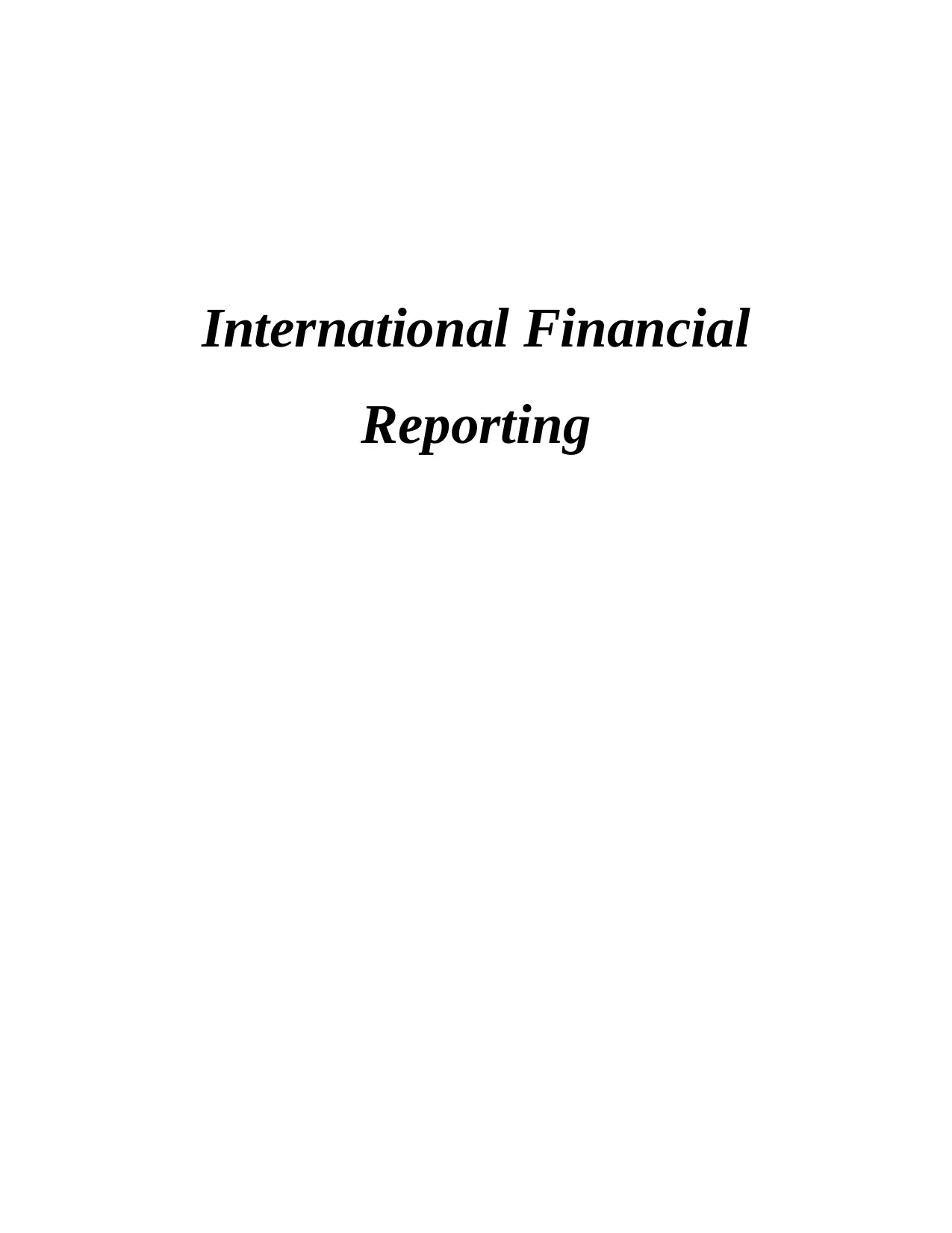
International Financial
Reporting
Reporting
Secure Best Marks with AI Grader
Need help grading? Try our AI Grader for instant feedback on your assignments.
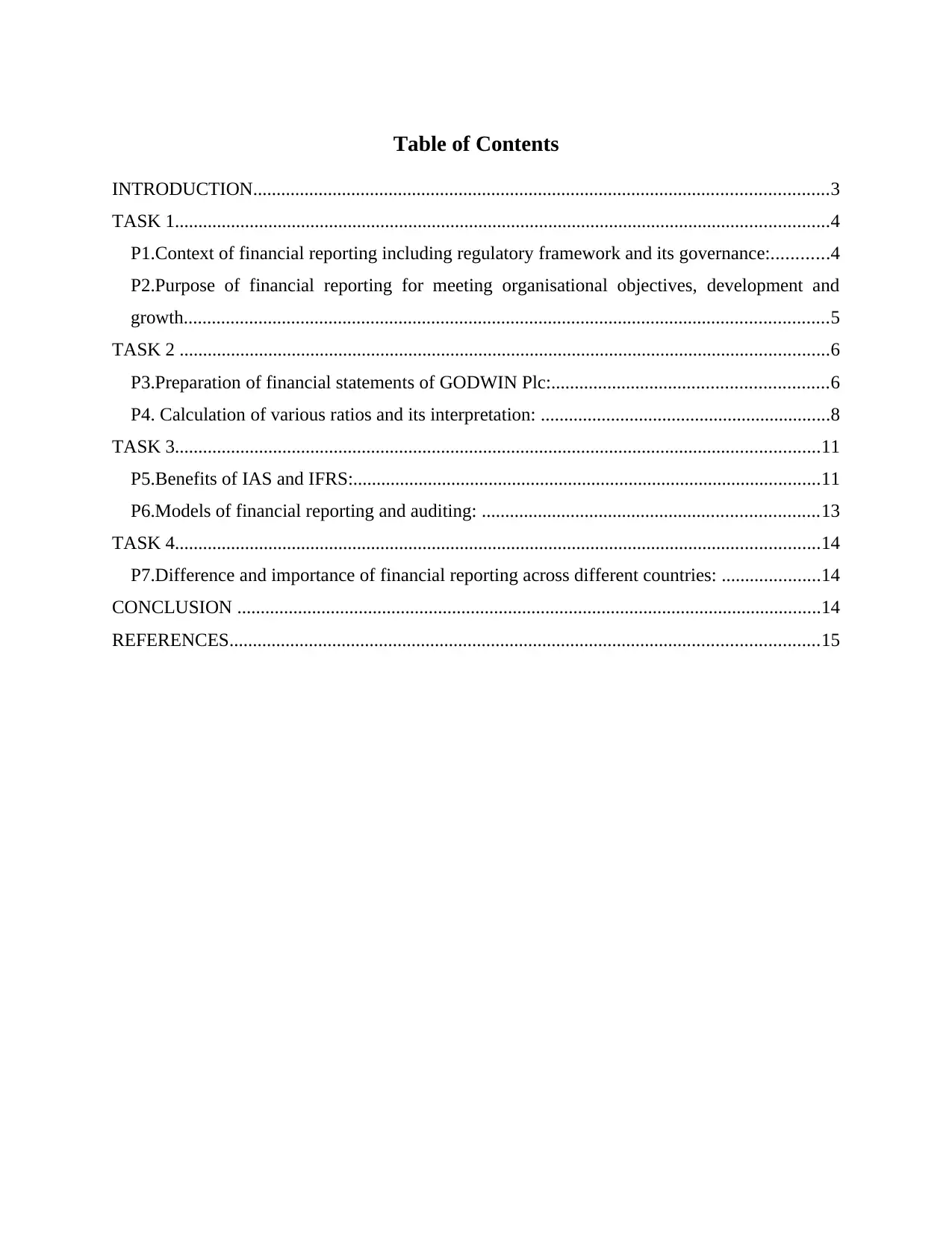
Table of Contents
INTRODUCTION...........................................................................................................................3
TASK 1............................................................................................................................................4
P1.Context of financial reporting including regulatory framework and its governance:............4
P2.Purpose of financial reporting for meeting organisational objectives, development and
growth..........................................................................................................................................5
TASK 2 ...........................................................................................................................................6
P3.Preparation of financial statements of GODWIN Plc:...........................................................6
P4. Calculation of various ratios and its interpretation: ..............................................................8
TASK 3..........................................................................................................................................11
P5.Benefits of IAS and IFRS:....................................................................................................11
P6.Models of financial reporting and auditing: ........................................................................13
TASK 4..........................................................................................................................................14
P7.Difference and importance of financial reporting across different countries: .....................14
CONCLUSION .............................................................................................................................14
REFERENCES..............................................................................................................................15
INTRODUCTION...........................................................................................................................3
TASK 1............................................................................................................................................4
P1.Context of financial reporting including regulatory framework and its governance:............4
P2.Purpose of financial reporting for meeting organisational objectives, development and
growth..........................................................................................................................................5
TASK 2 ...........................................................................................................................................6
P3.Preparation of financial statements of GODWIN Plc:...........................................................6
P4. Calculation of various ratios and its interpretation: ..............................................................8
TASK 3..........................................................................................................................................11
P5.Benefits of IAS and IFRS:....................................................................................................11
P6.Models of financial reporting and auditing: ........................................................................13
TASK 4..........................................................................................................................................14
P7.Difference and importance of financial reporting across different countries: .....................14
CONCLUSION .............................................................................................................................14
REFERENCES..............................................................................................................................15

INTRODUCTION
In any business environment, financial reporting of its business operations are essential
for providing true and fair view of affairs of company to its shareholders and other stakeholders.
For any multinational business organisation, international financial reporting shall be required
for follow the different countries laws and regulations. International financial reporting
frameworks set common rules for preparation of financial statements which are consistent and
transparent around the world.
For better understanding of international financial reporting, a business firm named
Deloitte is chosen which is engaged in providing professional consultancy services. It specializes
in audit and assurance, tax, advisory and risk. This report explains about the context and
purposes of financial accounting reporting for meeting business related growth and objectives. It
provides interpretation of financial statements by calculating various ratios. This report
prescribes the benefits of international accounting standards (IAS) and IFRS and various models
financial reporting and auditing. It also provides the differences and importance of financial
reporting across different countries.
TASK 1
P1.Context of financial reporting including regulatory framework and its governance:
Financial reporting concerns with the annual disclosure requirements of financial
statements which includes income & expenditure statement, balance sheet and cash flows to the
management and concerned stakeholders. It is a regulatory norm to disclose critical financial
data by the organisation to the general public in order to ensure transparency, diligence and
accountability. It is integral to corporate governance. The stakeholders who are deeply concerned
with an organisation's financial health are investors, creditors, regulators, financial institutions,
government and society at large. Deloitte Ensues financial reporting as vital to its operations and
to satisfy the needs to disclose critical information to the public it annually meets its disclosure
requirements (Nobes, 2014).
Regulatory framework:
Company law 2006 recognises International financial reporting standards (IFRS) UK and
Generally accepted accounting practices (GAAP) as standard principles to record financial
statements and follow guidelines issued by these standards for disclosure requirements . FRS 100
In any business environment, financial reporting of its business operations are essential
for providing true and fair view of affairs of company to its shareholders and other stakeholders.
For any multinational business organisation, international financial reporting shall be required
for follow the different countries laws and regulations. International financial reporting
frameworks set common rules for preparation of financial statements which are consistent and
transparent around the world.
For better understanding of international financial reporting, a business firm named
Deloitte is chosen which is engaged in providing professional consultancy services. It specializes
in audit and assurance, tax, advisory and risk. This report explains about the context and
purposes of financial accounting reporting for meeting business related growth and objectives. It
provides interpretation of financial statements by calculating various ratios. This report
prescribes the benefits of international accounting standards (IAS) and IFRS and various models
financial reporting and auditing. It also provides the differences and importance of financial
reporting across different countries.
TASK 1
P1.Context of financial reporting including regulatory framework and its governance:
Financial reporting concerns with the annual disclosure requirements of financial
statements which includes income & expenditure statement, balance sheet and cash flows to the
management and concerned stakeholders. It is a regulatory norm to disclose critical financial
data by the organisation to the general public in order to ensure transparency, diligence and
accountability. It is integral to corporate governance. The stakeholders who are deeply concerned
with an organisation's financial health are investors, creditors, regulators, financial institutions,
government and society at large. Deloitte Ensues financial reporting as vital to its operations and
to satisfy the needs to disclose critical information to the public it annually meets its disclosure
requirements (Nobes, 2014).
Regulatory framework:
Company law 2006 recognises International financial reporting standards (IFRS) UK and
Generally accepted accounting practices (GAAP) as standard principles to record financial
statements and follow guidelines issued by these standards for disclosure requirements . FRS 100
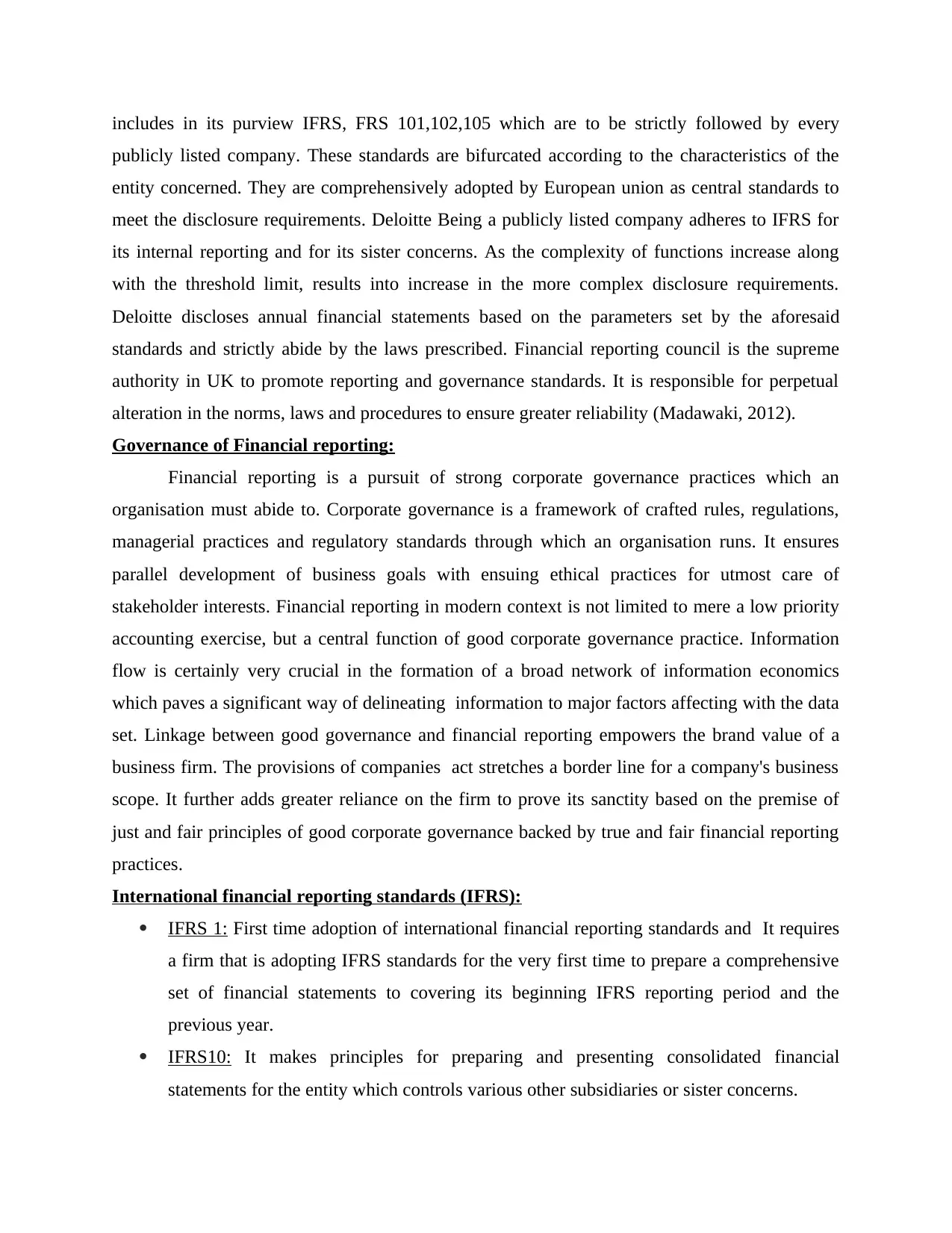
includes in its purview IFRS, FRS 101,102,105 which are to be strictly followed by every
publicly listed company. These standards are bifurcated according to the characteristics of the
entity concerned. They are comprehensively adopted by European union as central standards to
meet the disclosure requirements. Deloitte Being a publicly listed company adheres to IFRS for
its internal reporting and for its sister concerns. As the complexity of functions increase along
with the threshold limit, results into increase in the more complex disclosure requirements.
Deloitte discloses annual financial statements based on the parameters set by the aforesaid
standards and strictly abide by the laws prescribed. Financial reporting council is the supreme
authority in UK to promote reporting and governance standards. It is responsible for perpetual
alteration in the norms, laws and procedures to ensure greater reliability (Madawaki, 2012).
Governance of Financial reporting:
Financial reporting is a pursuit of strong corporate governance practices which an
organisation must abide to. Corporate governance is a framework of crafted rules, regulations,
managerial practices and regulatory standards through which an organisation runs. It ensures
parallel development of business goals with ensuing ethical practices for utmost care of
stakeholder interests. Financial reporting in modern context is not limited to mere a low priority
accounting exercise, but a central function of good corporate governance practice. Information
flow is certainly very crucial in the formation of a broad network of information economics
which paves a significant way of delineating information to major factors affecting with the data
set. Linkage between good governance and financial reporting empowers the brand value of a
business firm. The provisions of companies act stretches a border line for a company's business
scope. It further adds greater reliance on the firm to prove its sanctity based on the premise of
just and fair principles of good corporate governance backed by true and fair financial reporting
practices.
International financial reporting standards (IFRS):
IFRS 1: First time adoption of international financial reporting standards and It requires
a firm that is adopting IFRS standards for the very first time to prepare a comprehensive
set of financial statements to covering its beginning IFRS reporting period and the
previous year.
IFRS10: It makes principles for preparing and presenting consolidated financial
statements for the entity which controls various other subsidiaries or sister concerns.
publicly listed company. These standards are bifurcated according to the characteristics of the
entity concerned. They are comprehensively adopted by European union as central standards to
meet the disclosure requirements. Deloitte Being a publicly listed company adheres to IFRS for
its internal reporting and for its sister concerns. As the complexity of functions increase along
with the threshold limit, results into increase in the more complex disclosure requirements.
Deloitte discloses annual financial statements based on the parameters set by the aforesaid
standards and strictly abide by the laws prescribed. Financial reporting council is the supreme
authority in UK to promote reporting and governance standards. It is responsible for perpetual
alteration in the norms, laws and procedures to ensure greater reliability (Madawaki, 2012).
Governance of Financial reporting:
Financial reporting is a pursuit of strong corporate governance practices which an
organisation must abide to. Corporate governance is a framework of crafted rules, regulations,
managerial practices and regulatory standards through which an organisation runs. It ensures
parallel development of business goals with ensuing ethical practices for utmost care of
stakeholder interests. Financial reporting in modern context is not limited to mere a low priority
accounting exercise, but a central function of good corporate governance practice. Information
flow is certainly very crucial in the formation of a broad network of information economics
which paves a significant way of delineating information to major factors affecting with the data
set. Linkage between good governance and financial reporting empowers the brand value of a
business firm. The provisions of companies act stretches a border line for a company's business
scope. It further adds greater reliance on the firm to prove its sanctity based on the premise of
just and fair principles of good corporate governance backed by true and fair financial reporting
practices.
International financial reporting standards (IFRS):
IFRS 1: First time adoption of international financial reporting standards and It requires
a firm that is adopting IFRS standards for the very first time to prepare a comprehensive
set of financial statements to covering its beginning IFRS reporting period and the
previous year.
IFRS10: It makes principles for preparing and presenting consolidated financial
statements for the entity which controls various other subsidiaries or sister concerns.
Paraphrase This Document
Need a fresh take? Get an instant paraphrase of this document with our AI Paraphraser

IFRS 13: It prescribes framework to measure fair value, fair value and disclosure of the
fair value measurements.
P2.Purpose of financial reporting for meeting organisational objectives, development and growth
Financial reporting and organisational objectives:
An organisation going public for funds through initial public offering and other modes of
raising capital is concerned greatly with the meeting financial reporting standards. Since a huge
number of stakeholders directly or indirectly gets attached to an organisation when it goes
public, the reliance on emancipation of consolidated financial reporting increases manifold. The
objective of a business concern is to achieve its timely goals, earn maximum profits and acquire
market share in the relevant industry. All these objectives are realisable only when the financial
statements are prepared through modest IFRS standards. Stakeholders, most importantly
investors would only be interested in investing their wealth in the business only when the firm
has disclosed fair statements. The risk free & compliance feature would make the organisational
targets of acquiring funds more attractive than its competitors hence would result in full
achievement of its predetermined goals (Albu and Albu, 2012).
Financial reporting and organisational development:
The regulatory requirements are the biggest hurdles that can possibly daunt the corporate
image of any entity. There are regulatory norms like taxation norms, companies act compliances,
financial conduct authority, reporting and disclosures which every corporate entity shall duly
address. Promulgating robust financial reporting system would result into releasing extra
compliance burden. This is helpful in broadening the learning curve of a firm because it tries to
match up to the industry standards , it focuses on adhering to established laws, it charges on the
fore front to create a positive image in the market. All such measures taken in unison leads to the
perpetual organisational development in a phased manner. Financial reporting increases the
decision making capacity of the management because they are of the view that in the back end
the reporting standards are met with due diligence, further more the management can decipher
the mistakes they have been committing which in turn would result into experiential learning for
them in gradual stages (Ikpefan and Akande, 2012).
Financial reporting and organisational growth:
The maximum time the employees of an organisation spend is on compiling the data in
precise manner and doing analytics to produce self explanatory financial statements. The
fair value measurements.
P2.Purpose of financial reporting for meeting organisational objectives, development and growth
Financial reporting and organisational objectives:
An organisation going public for funds through initial public offering and other modes of
raising capital is concerned greatly with the meeting financial reporting standards. Since a huge
number of stakeholders directly or indirectly gets attached to an organisation when it goes
public, the reliance on emancipation of consolidated financial reporting increases manifold. The
objective of a business concern is to achieve its timely goals, earn maximum profits and acquire
market share in the relevant industry. All these objectives are realisable only when the financial
statements are prepared through modest IFRS standards. Stakeholders, most importantly
investors would only be interested in investing their wealth in the business only when the firm
has disclosed fair statements. The risk free & compliance feature would make the organisational
targets of acquiring funds more attractive than its competitors hence would result in full
achievement of its predetermined goals (Albu and Albu, 2012).
Financial reporting and organisational development:
The regulatory requirements are the biggest hurdles that can possibly daunt the corporate
image of any entity. There are regulatory norms like taxation norms, companies act compliances,
financial conduct authority, reporting and disclosures which every corporate entity shall duly
address. Promulgating robust financial reporting system would result into releasing extra
compliance burden. This is helpful in broadening the learning curve of a firm because it tries to
match up to the industry standards , it focuses on adhering to established laws, it charges on the
fore front to create a positive image in the market. All such measures taken in unison leads to the
perpetual organisational development in a phased manner. Financial reporting increases the
decision making capacity of the management because they are of the view that in the back end
the reporting standards are met with due diligence, further more the management can decipher
the mistakes they have been committing which in turn would result into experiential learning for
them in gradual stages (Ikpefan and Akande, 2012).
Financial reporting and organisational growth:
The maximum time the employees of an organisation spend is on compiling the data in
precise manner and doing analytics to produce self explanatory financial statements. The
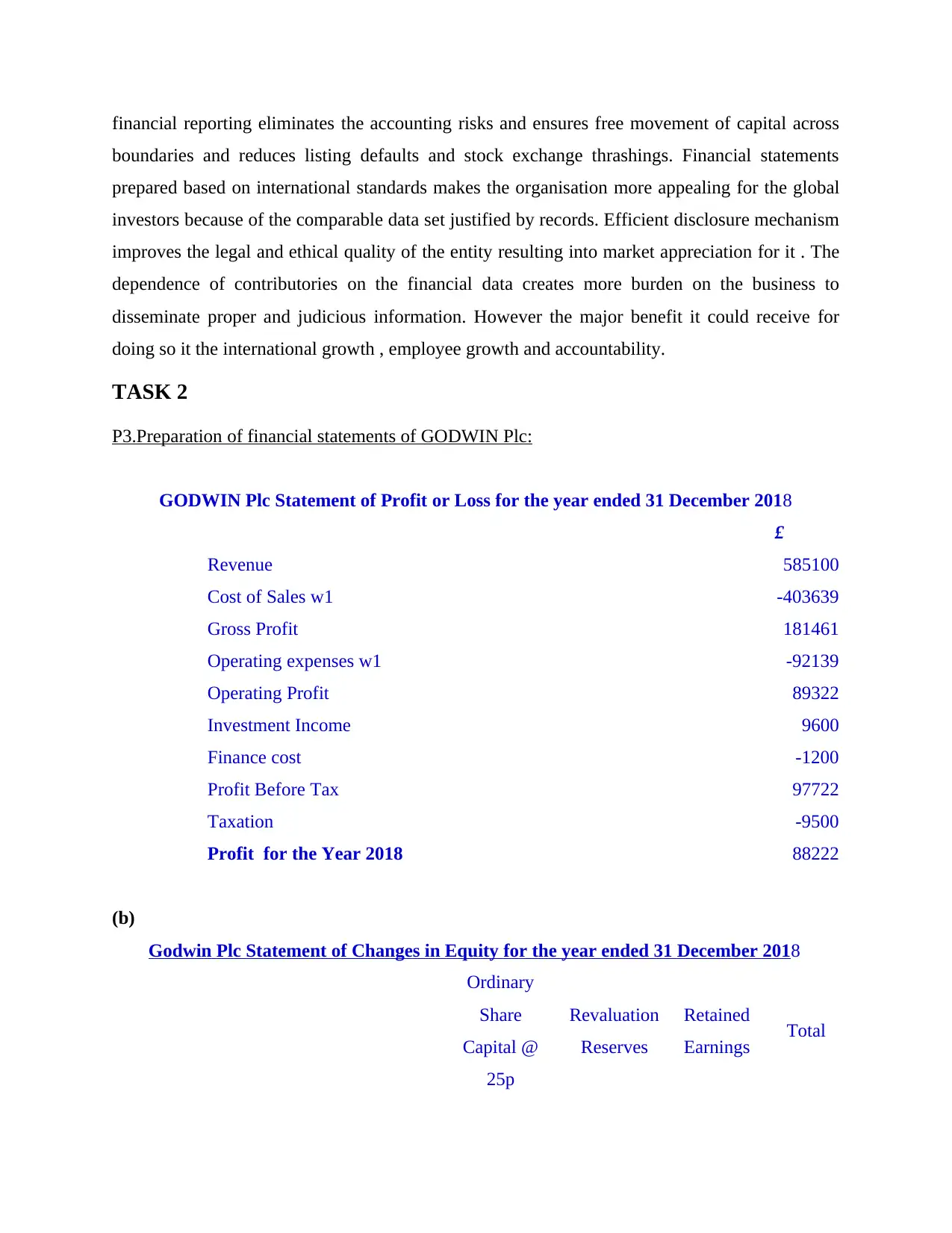
financial reporting eliminates the accounting risks and ensures free movement of capital across
boundaries and reduces listing defaults and stock exchange thrashings. Financial statements
prepared based on international standards makes the organisation more appealing for the global
investors because of the comparable data set justified by records. Efficient disclosure mechanism
improves the legal and ethical quality of the entity resulting into market appreciation for it . The
dependence of contributories on the financial data creates more burden on the business to
disseminate proper and judicious information. However the major benefit it could receive for
doing so it the international growth , employee growth and accountability.
TASK 2
P3.Preparation of financial statements of GODWIN Plc:
GODWIN Plc Statement of Profit or Loss for the year ended 31 December 2018
£
Revenue 585100
Cost of Sales w1 -403639
Gross Profit 181461
Operating expenses w1 -92139
Operating Profit 89322
Investment Income 9600
Finance cost -1200
Profit Before Tax 97722
Taxation -9500
Profit for the Year 2018 88222
(b)
Godwin Plc Statement of Changes in Equity for the year ended 31 December 2018
Ordinary
Share
Capital @
25p
Revaluation
Reserves
Retained
Earnings Total
boundaries and reduces listing defaults and stock exchange thrashings. Financial statements
prepared based on international standards makes the organisation more appealing for the global
investors because of the comparable data set justified by records. Efficient disclosure mechanism
improves the legal and ethical quality of the entity resulting into market appreciation for it . The
dependence of contributories on the financial data creates more burden on the business to
disseminate proper and judicious information. However the major benefit it could receive for
doing so it the international growth , employee growth and accountability.
TASK 2
P3.Preparation of financial statements of GODWIN Plc:
GODWIN Plc Statement of Profit or Loss for the year ended 31 December 2018
£
Revenue 585100
Cost of Sales w1 -403639
Gross Profit 181461
Operating expenses w1 -92139
Operating Profit 89322
Investment Income 9600
Finance cost -1200
Profit Before Tax 97722
Taxation -9500
Profit for the Year 2018 88222
(b)
Godwin Plc Statement of Changes in Equity for the year ended 31 December 2018
Ordinary
Share
Capital @
25p
Revaluation
Reserves
Retained
Earnings Total
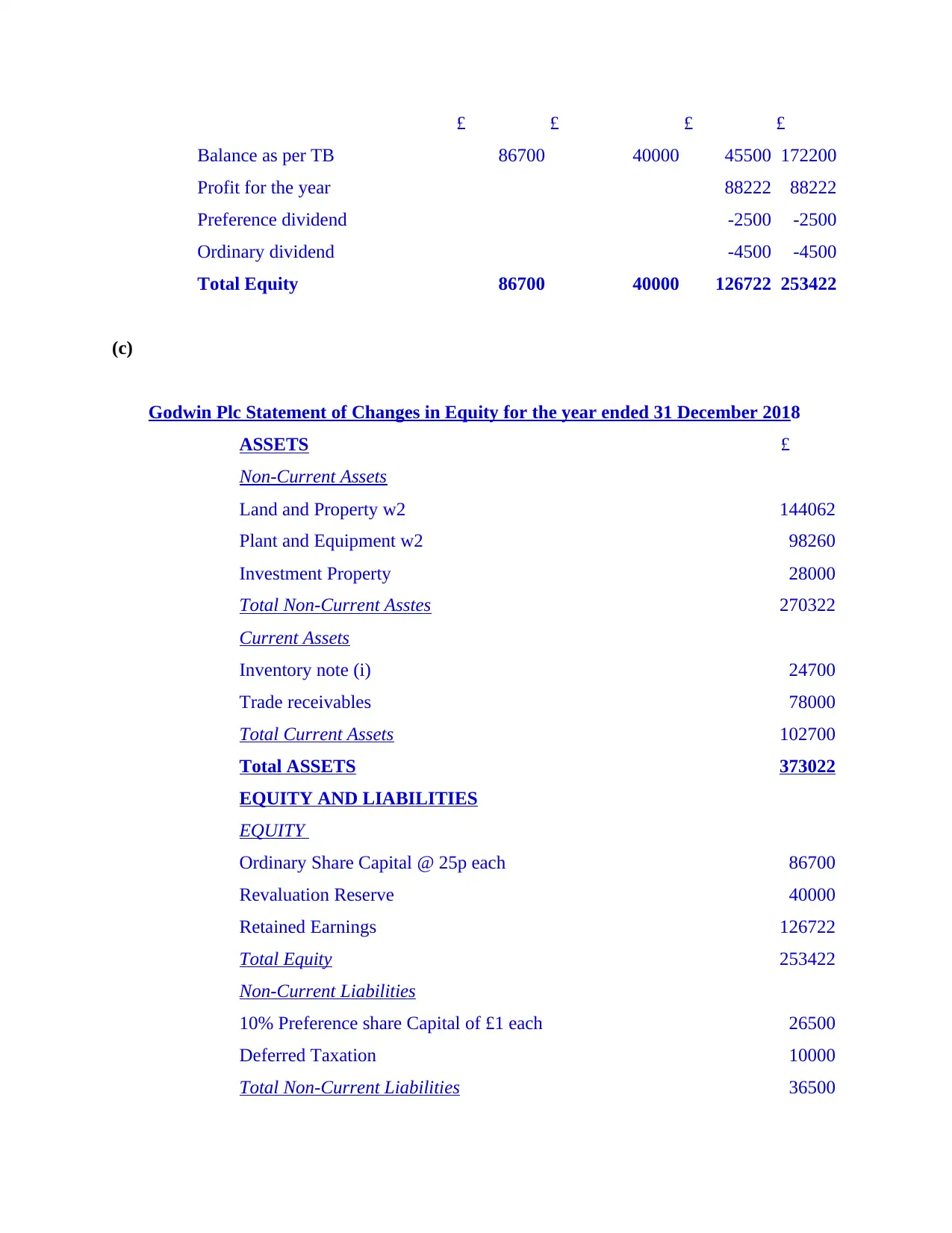
£ £ £ £
Balance as per TB 86700 40000 45500 172200
Profit for the year 88222 88222
Preference dividend -2500 -2500
Ordinary dividend -4500 -4500
Total Equity 86700 40000 126722 253422
(c)
Godwin Plc Statement of Changes in Equity for the year ended 31 December 2018
ASSETS £
Non-Current Assets
Land and Property w2 144062
Plant and Equipment w2 98260
Investment Property 28000
Total Non-Current Asstes 270322
Current Assets
Inventory note (i) 24700
Trade receivables 78000
Total Current Assets 102700
Total ASSETS 373022
EQUITY AND LIABILITIES
EQUITY
Ordinary Share Capital @ 25p each 86700
Revaluation Reserve 40000
Retained Earnings 126722
Total Equity 253422
Non-Current Liabilities
10% Preference share Capital of £1 each 26500
Deferred Taxation 10000
Total Non-Current Liabilities 36500
Balance as per TB 86700 40000 45500 172200
Profit for the year 88222 88222
Preference dividend -2500 -2500
Ordinary dividend -4500 -4500
Total Equity 86700 40000 126722 253422
(c)
Godwin Plc Statement of Changes in Equity for the year ended 31 December 2018
ASSETS £
Non-Current Assets
Land and Property w2 144062
Plant and Equipment w2 98260
Investment Property 28000
Total Non-Current Asstes 270322
Current Assets
Inventory note (i) 24700
Trade receivables 78000
Total Current Assets 102700
Total ASSETS 373022
EQUITY AND LIABILITIES
EQUITY
Ordinary Share Capital @ 25p each 86700
Revaluation Reserve 40000
Retained Earnings 126722
Total Equity 253422
Non-Current Liabilities
10% Preference share Capital of £1 each 26500
Deferred Taxation 10000
Total Non-Current Liabilities 36500
Secure Best Marks with AI Grader
Need help grading? Try our AI Grader for instant feedback on your assignments.
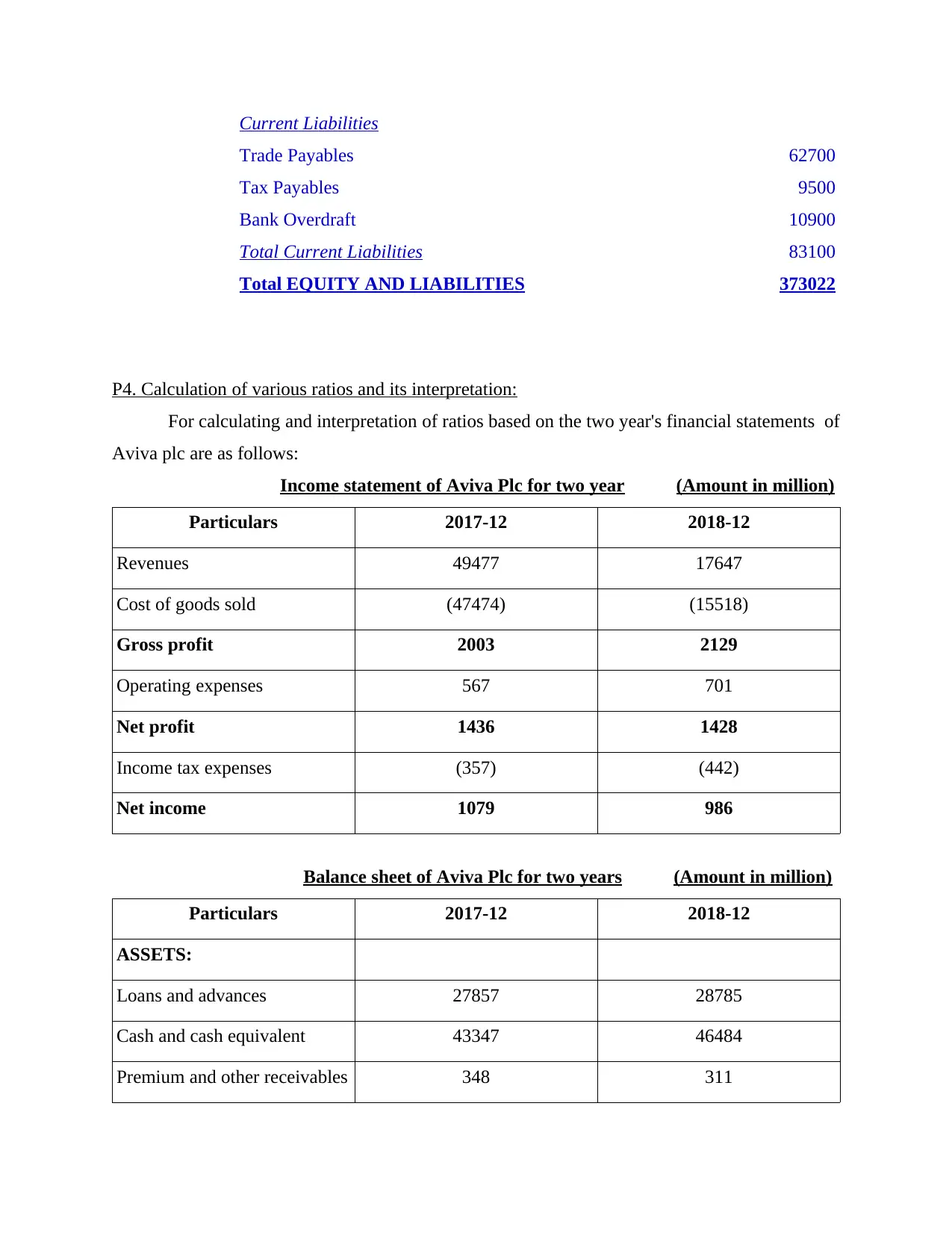
Current Liabilities
Trade Payables 62700
Tax Payables 9500
Bank Overdraft 10900
Total Current Liabilities 83100
Total EQUITY AND LIABILITIES 373022
P4. Calculation of various ratios and its interpretation:
For calculating and interpretation of ratios based on the two year's financial statements of
Aviva plc are as follows:
Income statement of Aviva Plc for two year (Amount in million)
Particulars 2017-12 2018-12
Revenues 49477 17647
Cost of goods sold (47474) (15518)
Gross profit 2003 2129
Operating expenses 567 701
Net profit 1436 1428
Income tax expenses (357) (442)
Net income 1079 986
Balance sheet of Aviva Plc for two years (Amount in million)
Particulars 2017-12 2018-12
ASSETS:
Loans and advances 27857 28785
Cash and cash equivalent 43347 46484
Premium and other receivables 348 311
Trade Payables 62700
Tax Payables 9500
Bank Overdraft 10900
Total Current Liabilities 83100
Total EQUITY AND LIABILITIES 373022
P4. Calculation of various ratios and its interpretation:
For calculating and interpretation of ratios based on the two year's financial statements of
Aviva plc are as follows:
Income statement of Aviva Plc for two year (Amount in million)
Particulars 2017-12 2018-12
Revenues 49477 17647
Cost of goods sold (47474) (15518)
Gross profit 2003 2129
Operating expenses 567 701
Net profit 1436 1428
Income tax expenses (357) (442)
Net income 1079 986
Balance sheet of Aviva Plc for two years (Amount in million)
Particulars 2017-12 2018-12
ASSETS:
Loans and advances 27857 28785
Cash and cash equivalent 43347 46484
Premium and other receivables 348 311
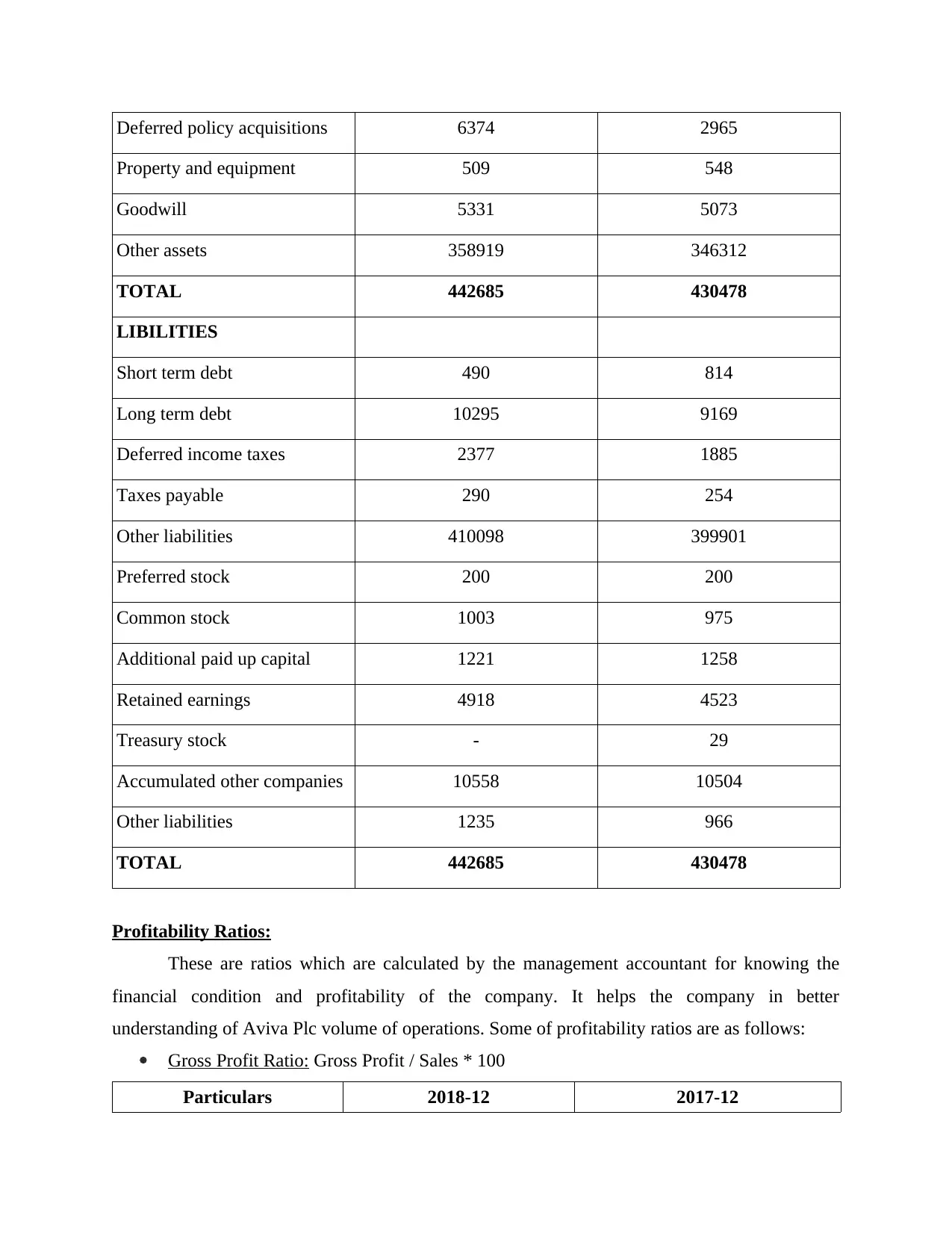
Deferred policy acquisitions 6374 2965
Property and equipment 509 548
Goodwill 5331 5073
Other assets 358919 346312
TOTAL 442685 430478
LIBILITIES
Short term debt 490 814
Long term debt 10295 9169
Deferred income taxes 2377 1885
Taxes payable 290 254
Other liabilities 410098 399901
Preferred stock 200 200
Common stock 1003 975
Additional paid up capital 1221 1258
Retained earnings 4918 4523
Treasury stock - 29
Accumulated other companies 10558 10504
Other liabilities 1235 966
TOTAL 442685 430478
Profitability Ratios:
These are ratios which are calculated by the management accountant for knowing the
financial condition and profitability of the company. It helps the company in better
understanding of Aviva Plc volume of operations. Some of profitability ratios are as follows:
Gross Profit Ratio: Gross Profit / Sales * 100
Particulars 2018-12 2017-12
Property and equipment 509 548
Goodwill 5331 5073
Other assets 358919 346312
TOTAL 442685 430478
LIBILITIES
Short term debt 490 814
Long term debt 10295 9169
Deferred income taxes 2377 1885
Taxes payable 290 254
Other liabilities 410098 399901
Preferred stock 200 200
Common stock 1003 975
Additional paid up capital 1221 1258
Retained earnings 4918 4523
Treasury stock - 29
Accumulated other companies 10558 10504
Other liabilities 1235 966
TOTAL 442685 430478
Profitability Ratios:
These are ratios which are calculated by the management accountant for knowing the
financial condition and profitability of the company. It helps the company in better
understanding of Aviva Plc volume of operations. Some of profitability ratios are as follows:
Gross Profit Ratio: Gross Profit / Sales * 100
Particulars 2018-12 2017-12
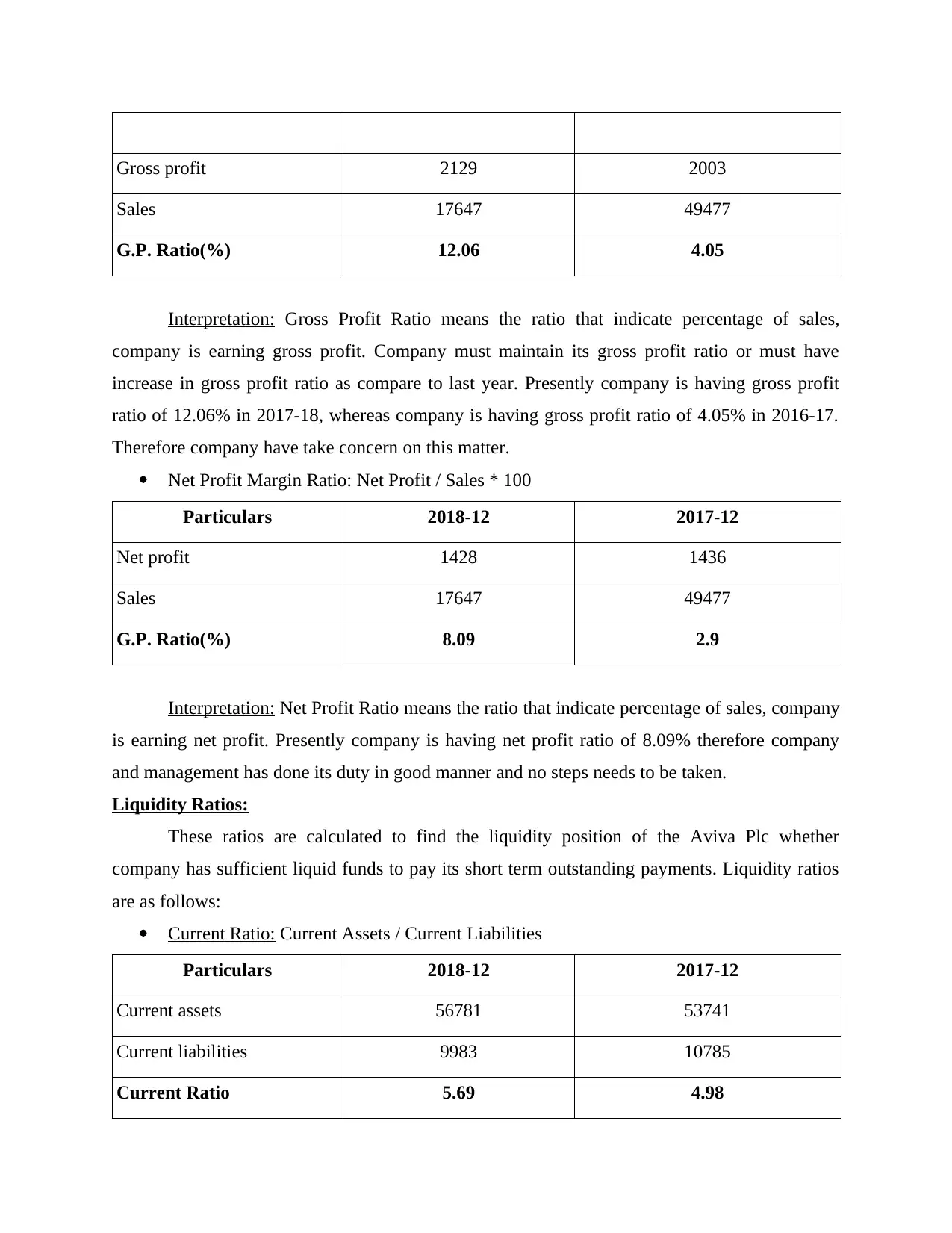
Gross profit 2129 2003
Sales 17647 49477
G.P. Ratio(%) 12.06 4.05
Interpretation: Gross Profit Ratio means the ratio that indicate percentage of sales,
company is earning gross profit. Company must maintain its gross profit ratio or must have
increase in gross profit ratio as compare to last year. Presently company is having gross profit
ratio of 12.06% in 2017-18, whereas company is having gross profit ratio of 4.05% in 2016-17.
Therefore company have take concern on this matter.
Net Profit Margin Ratio: Net Profit / Sales * 100
Particulars 2018-12 2017-12
Net profit 1428 1436
Sales 17647 49477
G.P. Ratio(%) 8.09 2.9
Interpretation: Net Profit Ratio means the ratio that indicate percentage of sales, company
is earning net profit. Presently company is having net profit ratio of 8.09% therefore company
and management has done its duty in good manner and no steps needs to be taken.
Liquidity Ratios:
These ratios are calculated to find the liquidity position of the Aviva Plc whether
company has sufficient liquid funds to pay its short term outstanding payments. Liquidity ratios
are as follows:
Current Ratio: Current Assets / Current Liabilities
Particulars 2018-12 2017-12
Current assets 56781 53741
Current liabilities 9983 10785
Current Ratio 5.69 4.98
Sales 17647 49477
G.P. Ratio(%) 12.06 4.05
Interpretation: Gross Profit Ratio means the ratio that indicate percentage of sales,
company is earning gross profit. Company must maintain its gross profit ratio or must have
increase in gross profit ratio as compare to last year. Presently company is having gross profit
ratio of 12.06% in 2017-18, whereas company is having gross profit ratio of 4.05% in 2016-17.
Therefore company have take concern on this matter.
Net Profit Margin Ratio: Net Profit / Sales * 100
Particulars 2018-12 2017-12
Net profit 1428 1436
Sales 17647 49477
G.P. Ratio(%) 8.09 2.9
Interpretation: Net Profit Ratio means the ratio that indicate percentage of sales, company
is earning net profit. Presently company is having net profit ratio of 8.09% therefore company
and management has done its duty in good manner and no steps needs to be taken.
Liquidity Ratios:
These ratios are calculated to find the liquidity position of the Aviva Plc whether
company has sufficient liquid funds to pay its short term outstanding payments. Liquidity ratios
are as follows:
Current Ratio: Current Assets / Current Liabilities
Particulars 2018-12 2017-12
Current assets 56781 53741
Current liabilities 9983 10785
Current Ratio 5.69 4.98
Paraphrase This Document
Need a fresh take? Get an instant paraphrase of this document with our AI Paraphraser
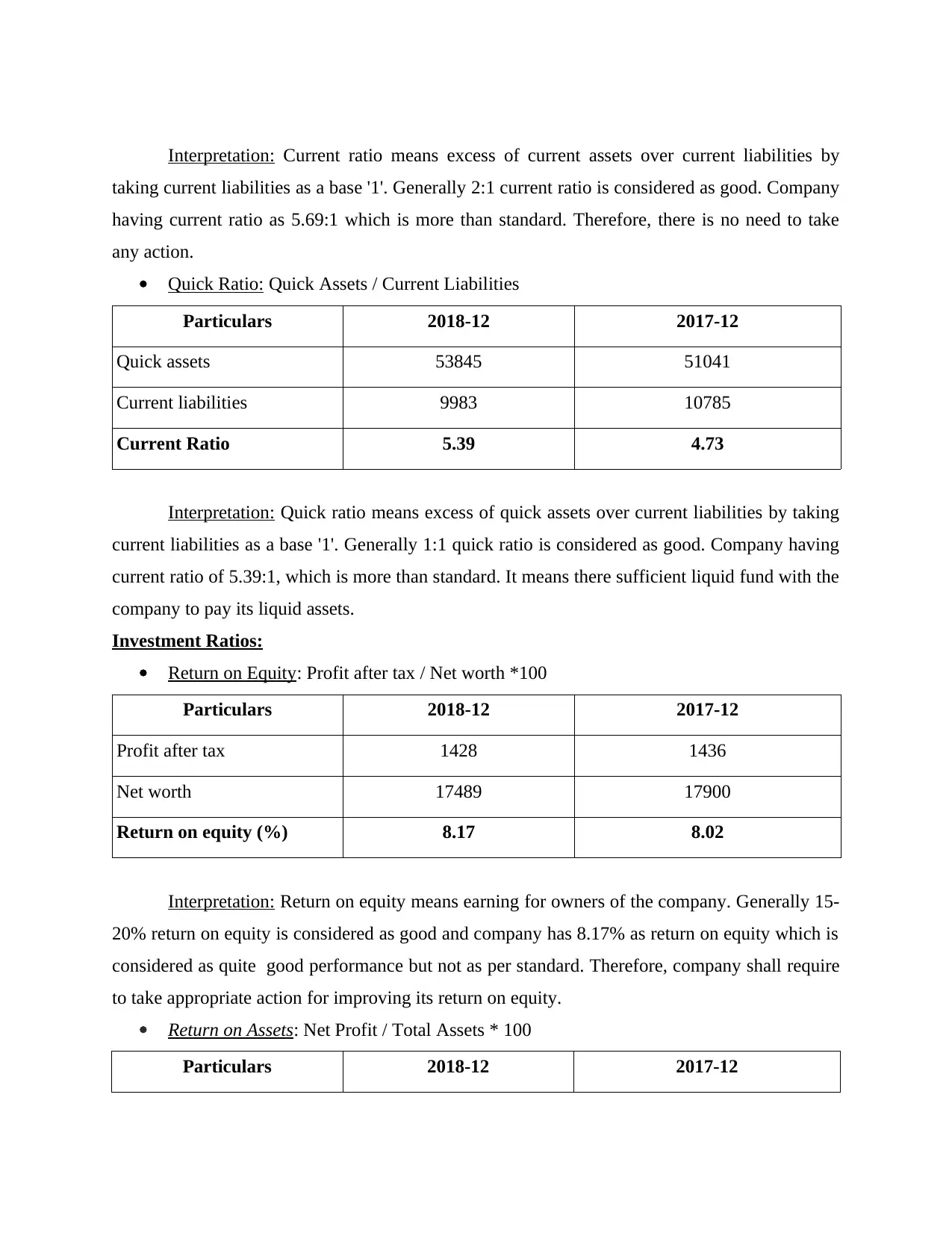
Interpretation: Current ratio means excess of current assets over current liabilities by
taking current liabilities as a base '1'. Generally 2:1 current ratio is considered as good. Company
having current ratio as 5.69:1 which is more than standard. Therefore, there is no need to take
any action.
Quick Ratio: Quick Assets / Current Liabilities
Particulars 2018-12 2017-12
Quick assets 53845 51041
Current liabilities 9983 10785
Current Ratio 5.39 4.73
Interpretation: Quick ratio means excess of quick assets over current liabilities by taking
current liabilities as a base '1'. Generally 1:1 quick ratio is considered as good. Company having
current ratio of 5.39:1, which is more than standard. It means there sufficient liquid fund with the
company to pay its liquid assets.
Investment Ratios:
Return on Equity: Profit after tax / Net worth *100
Particulars 2018-12 2017-12
Profit after tax 1428 1436
Net worth 17489 17900
Return on equity (%) 8.17 8.02
Interpretation: Return on equity means earning for owners of the company. Generally 15-
20% return on equity is considered as good and company has 8.17% as return on equity which is
considered as quite good performance but not as per standard. Therefore, company shall require
to take appropriate action for improving its return on equity.
Return on Assets: Net Profit / Total Assets * 100
Particulars 2018-12 2017-12
taking current liabilities as a base '1'. Generally 2:1 current ratio is considered as good. Company
having current ratio as 5.69:1 which is more than standard. Therefore, there is no need to take
any action.
Quick Ratio: Quick Assets / Current Liabilities
Particulars 2018-12 2017-12
Quick assets 53845 51041
Current liabilities 9983 10785
Current Ratio 5.39 4.73
Interpretation: Quick ratio means excess of quick assets over current liabilities by taking
current liabilities as a base '1'. Generally 1:1 quick ratio is considered as good. Company having
current ratio of 5.39:1, which is more than standard. It means there sufficient liquid fund with the
company to pay its liquid assets.
Investment Ratios:
Return on Equity: Profit after tax / Net worth *100
Particulars 2018-12 2017-12
Profit after tax 1428 1436
Net worth 17489 17900
Return on equity (%) 8.17 8.02
Interpretation: Return on equity means earning for owners of the company. Generally 15-
20% return on equity is considered as good and company has 8.17% as return on equity which is
considered as quite good performance but not as per standard. Therefore, company shall require
to take appropriate action for improving its return on equity.
Return on Assets: Net Profit / Total Assets * 100
Particulars 2018-12 2017-12
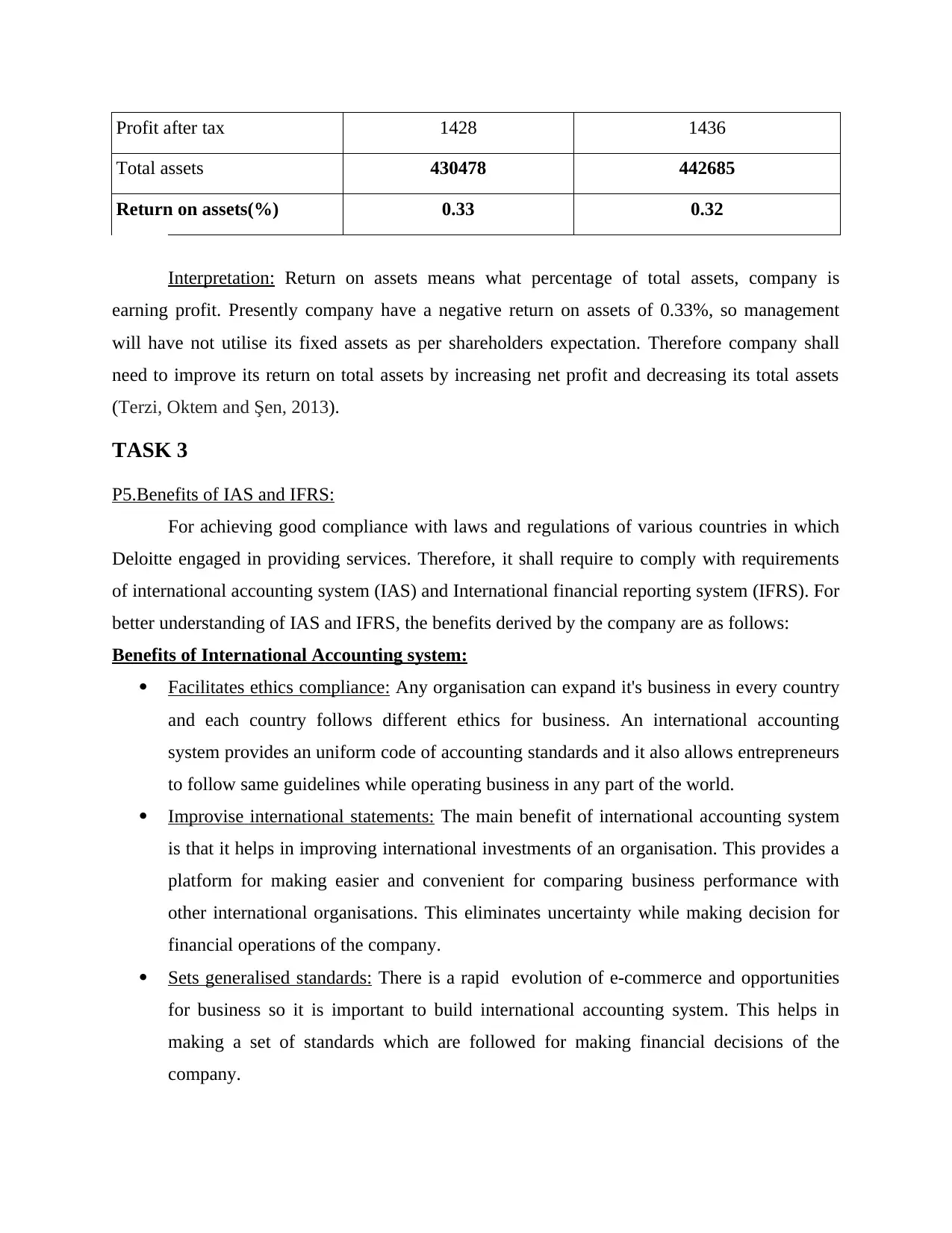
Profit after tax 1428 1436
Total assets 430478 442685
Return on assets(%) 0.33 0.32
Interpretation: Return on assets means what percentage of total assets, company is
earning profit. Presently company have a negative return on assets of 0.33%, so management
will have not utilise its fixed assets as per shareholders expectation. Therefore company shall
need to improve its return on total assets by increasing net profit and decreasing its total assets
(Terzi, Oktem and Şen, 2013).
TASK 3
P5.Benefits of IAS and IFRS:
For achieving good compliance with laws and regulations of various countries in which
Deloitte engaged in providing services. Therefore, it shall require to comply with requirements
of international accounting system (IAS) and International financial reporting system (IFRS). For
better understanding of IAS and IFRS, the benefits derived by the company are as follows:
Benefits of International Accounting system:
Facilitates ethics compliance: Any organisation can expand it's business in every country
and each country follows different ethics for business. An international accounting
system provides an uniform code of accounting standards and it also allows entrepreneurs
to follow same guidelines while operating business in any part of the world.
Improvise international statements: The main benefit of international accounting system
is that it helps in improving international investments of an organisation. This provides a
platform for making easier and convenient for comparing business performance with
other international organisations. This eliminates uncertainty while making decision for
financial operations of the company.
Sets generalised standards: There is a rapid evolution of e-commerce and opportunities
for business so it is important to build international accounting system. This helps in
making a set of standards which are followed for making financial decisions of the
company.
Total assets 430478 442685
Return on assets(%) 0.33 0.32
Interpretation: Return on assets means what percentage of total assets, company is
earning profit. Presently company have a negative return on assets of 0.33%, so management
will have not utilise its fixed assets as per shareholders expectation. Therefore company shall
need to improve its return on total assets by increasing net profit and decreasing its total assets
(Terzi, Oktem and Şen, 2013).
TASK 3
P5.Benefits of IAS and IFRS:
For achieving good compliance with laws and regulations of various countries in which
Deloitte engaged in providing services. Therefore, it shall require to comply with requirements
of international accounting system (IAS) and International financial reporting system (IFRS). For
better understanding of IAS and IFRS, the benefits derived by the company are as follows:
Benefits of International Accounting system:
Facilitates ethics compliance: Any organisation can expand it's business in every country
and each country follows different ethics for business. An international accounting
system provides an uniform code of accounting standards and it also allows entrepreneurs
to follow same guidelines while operating business in any part of the world.
Improvise international statements: The main benefit of international accounting system
is that it helps in improving international investments of an organisation. This provides a
platform for making easier and convenient for comparing business performance with
other international organisations. This eliminates uncertainty while making decision for
financial operations of the company.
Sets generalised standards: There is a rapid evolution of e-commerce and opportunities
for business so it is important to build international accounting system. This helps in
making a set of standards which are followed for making financial decisions of the
company.
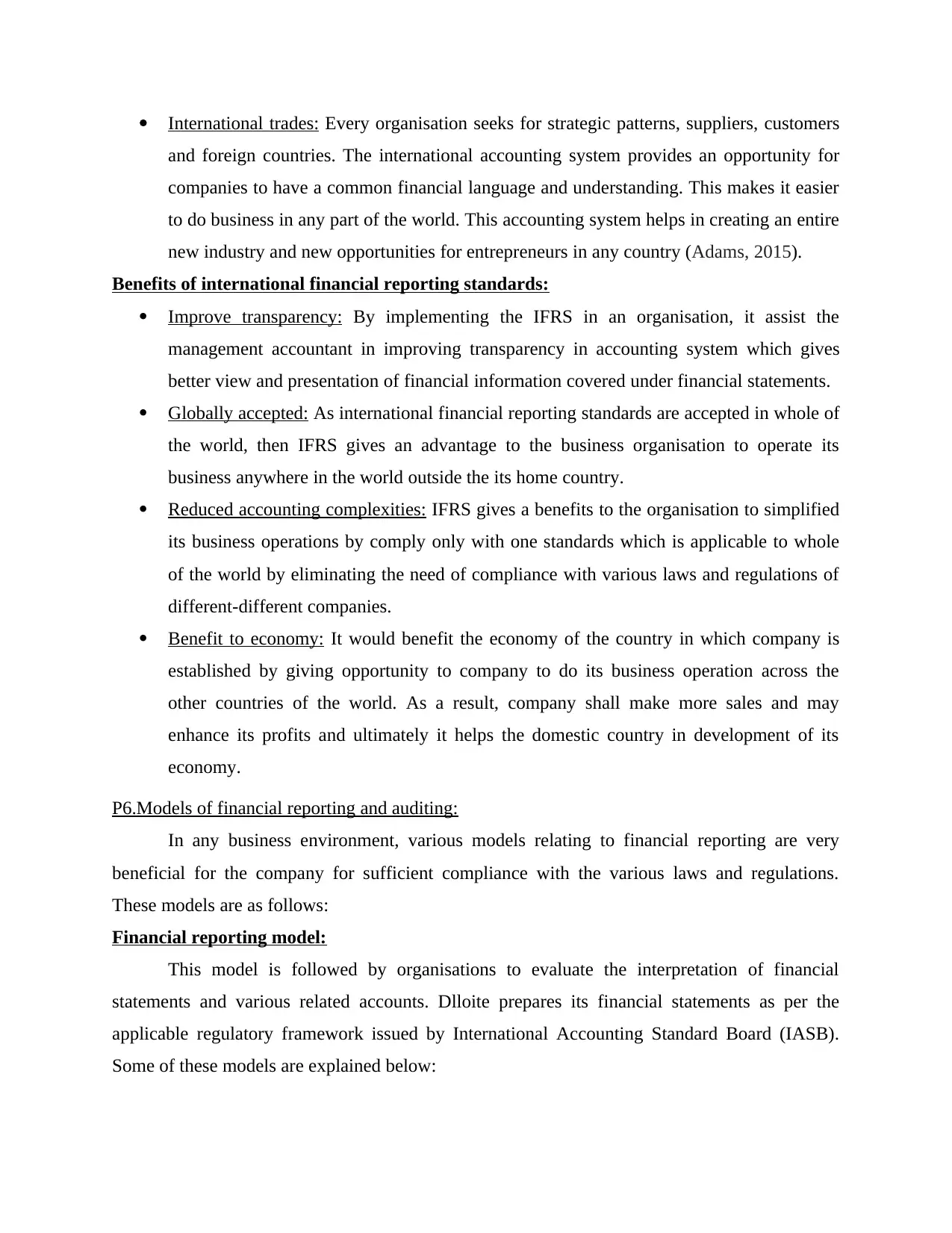
International trades: Every organisation seeks for strategic patterns, suppliers, customers
and foreign countries. The international accounting system provides an opportunity for
companies to have a common financial language and understanding. This makes it easier
to do business in any part of the world. This accounting system helps in creating an entire
new industry and new opportunities for entrepreneurs in any country (Adams, 2015).
Benefits of international financial reporting standards:
Improve transparency: By implementing the IFRS in an organisation, it assist the
management accountant in improving transparency in accounting system which gives
better view and presentation of financial information covered under financial statements.
Globally accepted: As international financial reporting standards are accepted in whole of
the world, then IFRS gives an advantage to the business organisation to operate its
business anywhere in the world outside the its home country.
Reduced accounting complexities: IFRS gives a benefits to the organisation to simplified
its business operations by comply only with one standards which is applicable to whole
of the world by eliminating the need of compliance with various laws and regulations of
different-different companies.
Benefit to economy: It would benefit the economy of the country in which company is
established by giving opportunity to company to do its business operation across the
other countries of the world. As a result, company shall make more sales and may
enhance its profits and ultimately it helps the domestic country in development of its
economy.
P6.Models of financial reporting and auditing:
In any business environment, various models relating to financial reporting are very
beneficial for the company for sufficient compliance with the various laws and regulations.
These models are as follows:
Financial reporting model:
This model is followed by organisations to evaluate the interpretation of financial
statements and various related accounts. Dlloite prepares its financial statements as per the
applicable regulatory framework issued by International Accounting Standard Board (IASB).
Some of these models are explained below:
and foreign countries. The international accounting system provides an opportunity for
companies to have a common financial language and understanding. This makes it easier
to do business in any part of the world. This accounting system helps in creating an entire
new industry and new opportunities for entrepreneurs in any country (Adams, 2015).
Benefits of international financial reporting standards:
Improve transparency: By implementing the IFRS in an organisation, it assist the
management accountant in improving transparency in accounting system which gives
better view and presentation of financial information covered under financial statements.
Globally accepted: As international financial reporting standards are accepted in whole of
the world, then IFRS gives an advantage to the business organisation to operate its
business anywhere in the world outside the its home country.
Reduced accounting complexities: IFRS gives a benefits to the organisation to simplified
its business operations by comply only with one standards which is applicable to whole
of the world by eliminating the need of compliance with various laws and regulations of
different-different companies.
Benefit to economy: It would benefit the economy of the country in which company is
established by giving opportunity to company to do its business operation across the
other countries of the world. As a result, company shall make more sales and may
enhance its profits and ultimately it helps the domestic country in development of its
economy.
P6.Models of financial reporting and auditing:
In any business environment, various models relating to financial reporting are very
beneficial for the company for sufficient compliance with the various laws and regulations.
These models are as follows:
Financial reporting model:
This model is followed by organisations to evaluate the interpretation of financial
statements and various related accounts. Dlloite prepares its financial statements as per the
applicable regulatory framework issued by International Accounting Standard Board (IASB).
Some of these models are explained below:
Secure Best Marks with AI Grader
Need help grading? Try our AI Grader for instant feedback on your assignments.

Three statement model: It is a type of model which is prepared by all companies to
analyse the financial position during an accounting year. It has three statements which is balance
sheet, income statement, cash flow statement. Balance sheet is a statement of financial position
that covers impact of assets, shareholder's fund and liabilities. This is made by organisations to
evaluate its working capital position. Presentation of balance sheet includes a 'T' shaped
presentation where assets are shown on the top followed by equity & liabilities. Assets are the
estate which cause economic enhancement to an entity whereas liabilities may be defined as a
current responsibility due to past happening. Profit & loss account may be defined as a statement
which record gains & losses which may appear within an accounting year. It is created by
entities to assess their profitability position. It covers revenue, cost of sales, administrative
expenses etc. Cash flow statement may be defined as a statement that records inflows and
outflows of cash for companies. It is made based on IAS-7. Statement of cash flows that includes
three activities i.e. operating, investing and financing. These consists of loss/profit on investment
and working capital changes, purchase/sale of fixed assets, issue/repayment of shares etc.
(Cheng, 2014).
Consolidation model: It is a model formulated by combining financial results of various
businesses into one model. It includes a parent and subsidiary company and created as
per requirements of IFRS-10 Consolidated financial statements. These are represented in
the form of tables in a spreadsheet or in the form of graphs or charts. It includes
calculation of goodwill, group retained earnings, non controlling interest, unrealised
profit etc. for preparation of final accounts of a company. The effect of IFRS-3 Business
combinations is also considered while preparing consolidated financial statements.
Auditing model: This is a type of model which provides systematic examination of
books, statutory records, vouchers etc. of an entity. This covers the various methods to
examine the wholeness of data. Some of them are given as follows:
Reconciliation: This is a method used by auditors to check any errors in the statement of
accounts. These are prepared to identify any misconduct, fraud or error, loss of theft
which may arise while preparing financial statements.
Physical examination: This requires verification and physical inspection of tangible assets
and other line items in balance sheet as it confirms their existence.
analyse the financial position during an accounting year. It has three statements which is balance
sheet, income statement, cash flow statement. Balance sheet is a statement of financial position
that covers impact of assets, shareholder's fund and liabilities. This is made by organisations to
evaluate its working capital position. Presentation of balance sheet includes a 'T' shaped
presentation where assets are shown on the top followed by equity & liabilities. Assets are the
estate which cause economic enhancement to an entity whereas liabilities may be defined as a
current responsibility due to past happening. Profit & loss account may be defined as a statement
which record gains & losses which may appear within an accounting year. It is created by
entities to assess their profitability position. It covers revenue, cost of sales, administrative
expenses etc. Cash flow statement may be defined as a statement that records inflows and
outflows of cash for companies. It is made based on IAS-7. Statement of cash flows that includes
three activities i.e. operating, investing and financing. These consists of loss/profit on investment
and working capital changes, purchase/sale of fixed assets, issue/repayment of shares etc.
(Cheng, 2014).
Consolidation model: It is a model formulated by combining financial results of various
businesses into one model. It includes a parent and subsidiary company and created as
per requirements of IFRS-10 Consolidated financial statements. These are represented in
the form of tables in a spreadsheet or in the form of graphs or charts. It includes
calculation of goodwill, group retained earnings, non controlling interest, unrealised
profit etc. for preparation of final accounts of a company. The effect of IFRS-3 Business
combinations is also considered while preparing consolidated financial statements.
Auditing model: This is a type of model which provides systematic examination of
books, statutory records, vouchers etc. of an entity. This covers the various methods to
examine the wholeness of data. Some of them are given as follows:
Reconciliation: This is a method used by auditors to check any errors in the statement of
accounts. These are prepared to identify any misconduct, fraud or error, loss of theft
which may arise while preparing financial statements.
Physical examination: This requires verification and physical inspection of tangible assets
and other line items in balance sheet as it confirms their existence.
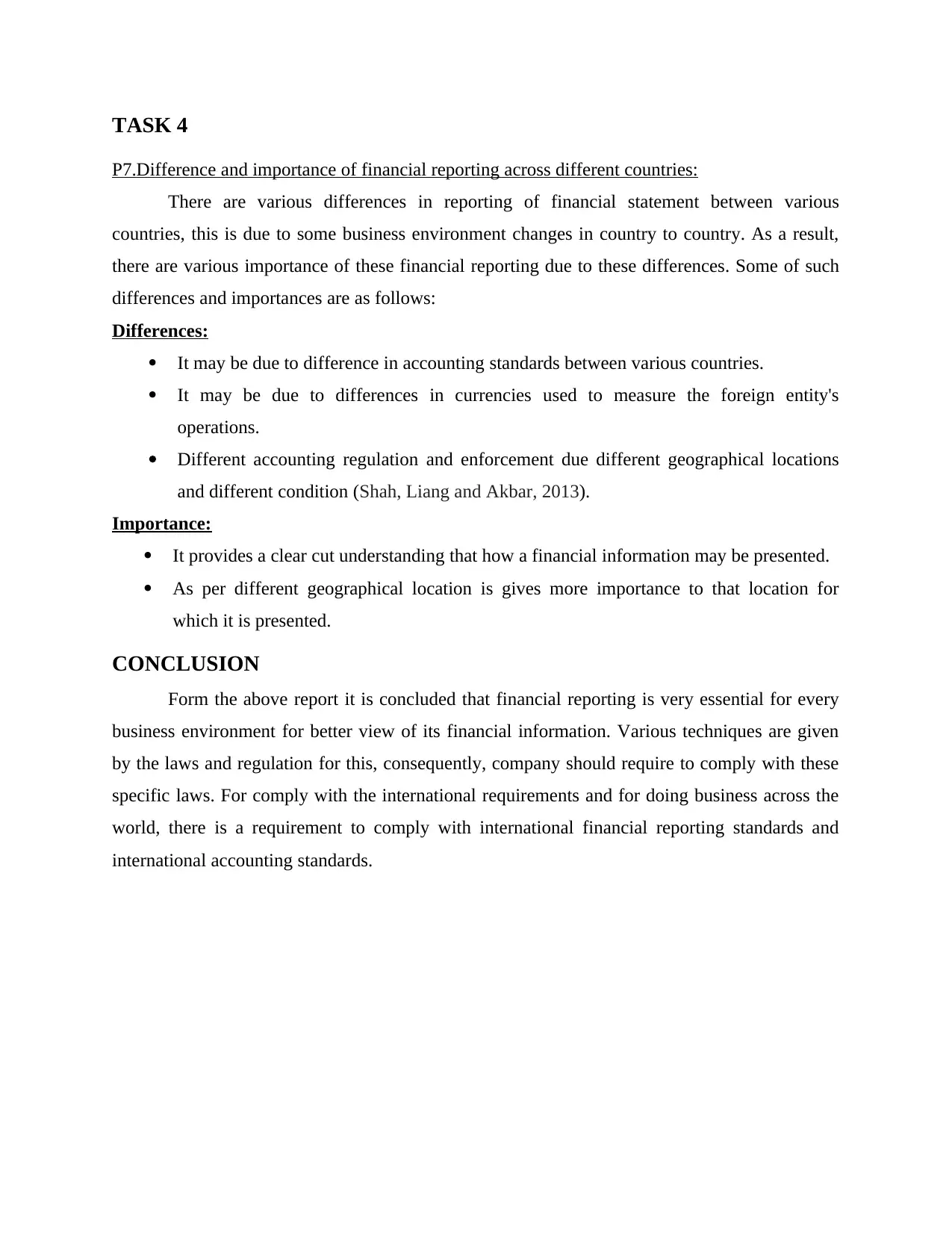
TASK 4
P7.Difference and importance of financial reporting across different countries:
There are various differences in reporting of financial statement between various
countries, this is due to some business environment changes in country to country. As a result,
there are various importance of these financial reporting due to these differences. Some of such
differences and importances are as follows:
Differences:
It may be due to difference in accounting standards between various countries.
It may be due to differences in currencies used to measure the foreign entity's
operations.
Different accounting regulation and enforcement due different geographical locations
and different condition (Shah, Liang and Akbar, 2013).
Importance:
It provides a clear cut understanding that how a financial information may be presented.
As per different geographical location is gives more importance to that location for
which it is presented.
CONCLUSION
Form the above report it is concluded that financial reporting is very essential for every
business environment for better view of its financial information. Various techniques are given
by the laws and regulation for this, consequently, company should require to comply with these
specific laws. For comply with the international requirements and for doing business across the
world, there is a requirement to comply with international financial reporting standards and
international accounting standards.
P7.Difference and importance of financial reporting across different countries:
There are various differences in reporting of financial statement between various
countries, this is due to some business environment changes in country to country. As a result,
there are various importance of these financial reporting due to these differences. Some of such
differences and importances are as follows:
Differences:
It may be due to difference in accounting standards between various countries.
It may be due to differences in currencies used to measure the foreign entity's
operations.
Different accounting regulation and enforcement due different geographical locations
and different condition (Shah, Liang and Akbar, 2013).
Importance:
It provides a clear cut understanding that how a financial information may be presented.
As per different geographical location is gives more importance to that location for
which it is presented.
CONCLUSION
Form the above report it is concluded that financial reporting is very essential for every
business environment for better view of its financial information. Various techniques are given
by the laws and regulation for this, consequently, company should require to comply with these
specific laws. For comply with the international requirements and for doing business across the
world, there is a requirement to comply with international financial reporting standards and
international accounting standards.
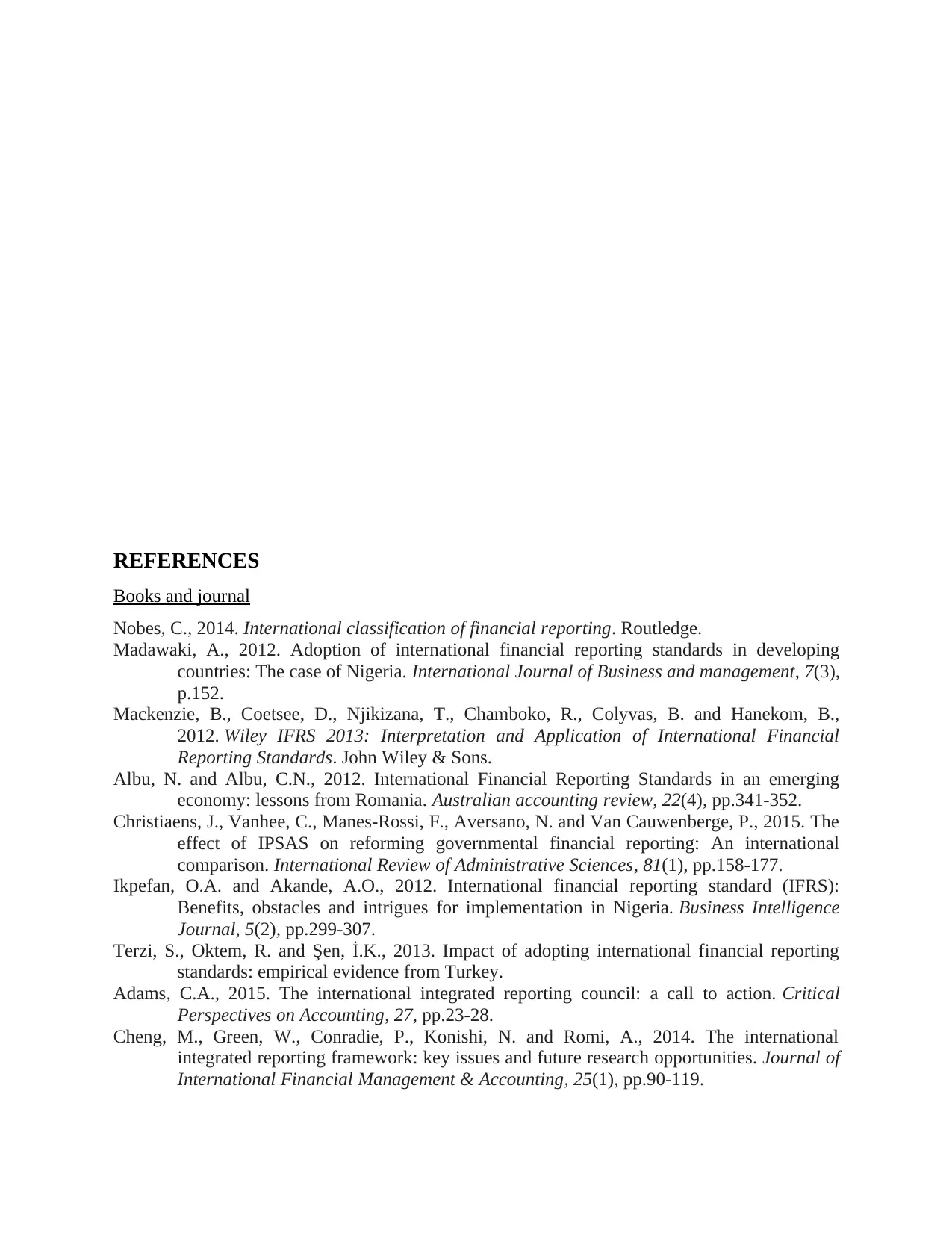
REFERENCES
Books and journal
Nobes, C., 2014. International classification of financial reporting. Routledge.
Madawaki, A., 2012. Adoption of international financial reporting standards in developing
countries: The case of Nigeria. International Journal of Business and management, 7(3),
p.152.
Mackenzie, B., Coetsee, D., Njikizana, T., Chamboko, R., Colyvas, B. and Hanekom, B.,
2012. Wiley IFRS 2013: Interpretation and Application of International Financial
Reporting Standards. John Wiley & Sons.
Albu, N. and Albu, C.N., 2012. International Financial Reporting Standards in an emerging
economy: lessons from Romania. Australian accounting review, 22(4), pp.341-352.
Christiaens, J., Vanhee, C., Manes-Rossi, F., Aversano, N. and Van Cauwenberge, P., 2015. The
effect of IPSAS on reforming governmental financial reporting: An international
comparison. International Review of Administrative Sciences, 81(1), pp.158-177.
Ikpefan, O.A. and Akande, A.O., 2012. International financial reporting standard (IFRS):
Benefits, obstacles and intrigues for implementation in Nigeria. Business Intelligence
Journal, 5(2), pp.299-307.
Terzi, S., Oktem, R. and Şen, İ.K., 2013. Impact of adopting international financial reporting
standards: empirical evidence from Turkey.
Adams, C.A., 2015. The international integrated reporting council: a call to action. Critical
Perspectives on Accounting, 27, pp.23-28.
Cheng, M., Green, W., Conradie, P., Konishi, N. and Romi, A., 2014. The international
integrated reporting framework: key issues and future research opportunities. Journal of
International Financial Management & Accounting, 25(1), pp.90-119.
Books and journal
Nobes, C., 2014. International classification of financial reporting. Routledge.
Madawaki, A., 2012. Adoption of international financial reporting standards in developing
countries: The case of Nigeria. International Journal of Business and management, 7(3),
p.152.
Mackenzie, B., Coetsee, D., Njikizana, T., Chamboko, R., Colyvas, B. and Hanekom, B.,
2012. Wiley IFRS 2013: Interpretation and Application of International Financial
Reporting Standards. John Wiley & Sons.
Albu, N. and Albu, C.N., 2012. International Financial Reporting Standards in an emerging
economy: lessons from Romania. Australian accounting review, 22(4), pp.341-352.
Christiaens, J., Vanhee, C., Manes-Rossi, F., Aversano, N. and Van Cauwenberge, P., 2015. The
effect of IPSAS on reforming governmental financial reporting: An international
comparison. International Review of Administrative Sciences, 81(1), pp.158-177.
Ikpefan, O.A. and Akande, A.O., 2012. International financial reporting standard (IFRS):
Benefits, obstacles and intrigues for implementation in Nigeria. Business Intelligence
Journal, 5(2), pp.299-307.
Terzi, S., Oktem, R. and Şen, İ.K., 2013. Impact of adopting international financial reporting
standards: empirical evidence from Turkey.
Adams, C.A., 2015. The international integrated reporting council: a call to action. Critical
Perspectives on Accounting, 27, pp.23-28.
Cheng, M., Green, W., Conradie, P., Konishi, N. and Romi, A., 2014. The international
integrated reporting framework: key issues and future research opportunities. Journal of
International Financial Management & Accounting, 25(1), pp.90-119.
Paraphrase This Document
Need a fresh take? Get an instant paraphrase of this document with our AI Paraphraser
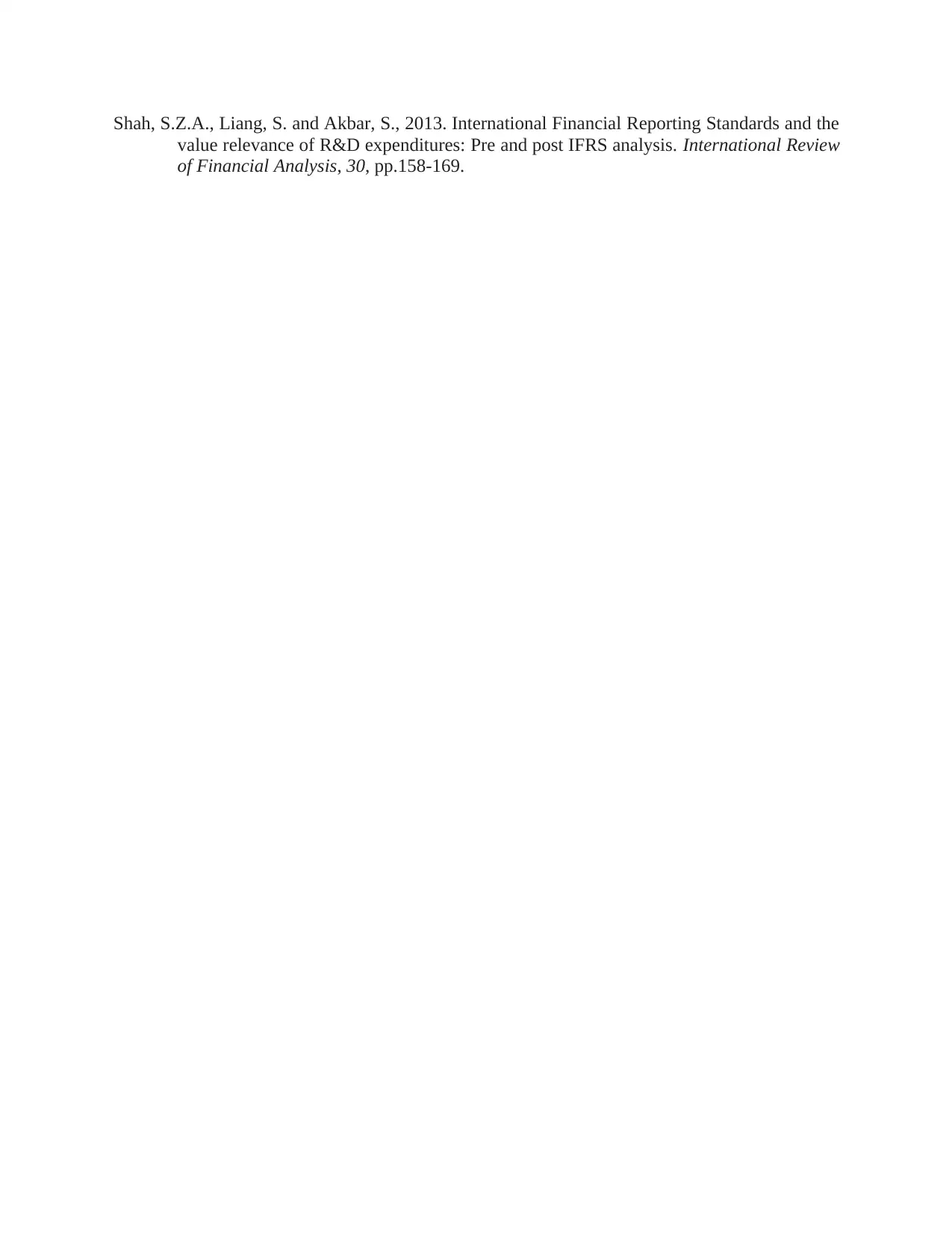
Shah, S.Z.A., Liang, S. and Akbar, S., 2013. International Financial Reporting Standards and the
value relevance of R&D expenditures: Pre and post IFRS analysis. International Review
of Financial Analysis, 30, pp.158-169.
value relevance of R&D expenditures: Pre and post IFRS analysis. International Review
of Financial Analysis, 30, pp.158-169.
1 out of 17
Related Documents
Your All-in-One AI-Powered Toolkit for Academic Success.
+13062052269
info@desklib.com
Available 24*7 on WhatsApp / Email
![[object Object]](/_next/static/media/star-bottom.7253800d.svg)
Unlock your academic potential
© 2024 | Zucol Services PVT LTD | All rights reserved.





